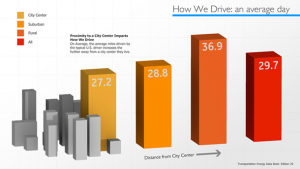Search Engine Optimization (SEO) is one of those things in life that’s always known to be a little finicky.
With each new Google algorithm change comes the need to make adjustments and begin playing by a new set of rules.
The only problem?
Google isn’t always forthcoming about what those rules are or how you abide by them.
This means there’s usually a secondary problem you have to consider — the dreaded Google penalty.
And while it is something that every knowledgeable SEO manager probably has nightmares about, the truth is that it doesn’t have to be that scary if you know what to expect and take action accordingly.
Welcome to our cumulative guide on Google penalties including what they are, how you can tell you’ve been penalized, and our eight favorite Google Penalty Checker Tools to help you fix your SEO problems.
Let’s dive in.
Download this post by entering your email below
What is a Google Penalty and How Long Does It Last?
A Google penalty is simply the search engine’s way of blocking certain websites that engage in tactics that either go against their guidelines or do not meet certain criteria.
During the penalty phase, a website can see a huge reduction in ranking position or an outright crash in traffic, all because Google is no longer showing it in the rankings.
For a business that is getting pretty consistent traffic overall, the process can be absolutely detrimental to sales and lead generation, which is why it is important to try to avoid getting one at all costs.
The good news?
Most digital marketers who only engage in white hat tactics should never have to deal with a Google penalty.
It is only those who go off course and engage in things like sneaky redirects and cloaked images that really have a reason to worry.
➤ For a list of known penalties, take a look at our black hat post.
So, how long does a Google penalty last?
If you’ve been unfortunate enough to be hit with one, you can expect it to take up to thirty days for a small infraction or longer for something major.
But be advised: Google penalties do expire on their own.
At that time, your website will be checked to ensure the problems are fixed and the penalty removed. If not, you could face another one.
How Do You Know If Your Website Is Penalized by Google?
Often, the only indicator you’ll receive that your website is penalized by Google is a sudden and extreme drop in traffic.
This is usually the first noticeable issue that you have a problem — and it is worth checking out.
However, that isn’t the end-all answer as to how you know you’ve been penalized by Google.
Some marketers don’t even realize that there’s an issue until they’ve used a checker tool or noticed in their favorite analytics program that there’s a warning.
To understand how Google issues penalties, it is important to realize that most are issued on a manual basis.
This means that a specific website is flagged for an issue and then a human checker reviews the issue to determine if there really is a problem.
Thus, this two-step towards the land of lost traffic is usually something that happens over time.
If you’ve just slipped up and made a tiny mistake, but corrected it immediately, you shouldn’t have a penalty issue.
What’s the Difference Between an Algorithm Change and a Penalty?
It’s important to understand that there’s a clear distinction between a universal Google algorithm change and a penalty.
An algorithm change (like BERT) is something that affects all websites, not just a select few.
Algorithm changes are designed to make the quality of search better for the end-user, which sometimes creates a drop in traffic for certain content.
A penalty is just what it sounds like — a punishment for engaging in specific activities that are against Google’s playbook of rules.
Think of it as like a time-out from getting traffic because of something you’ve done on your website, either intentionally or unintentionally.
Again, penalties are often issued manually, which means your website would have had the issue happening for an extended period of time.
Another way to tell that you have a penalty?
Algorithm changes are very widely publicized. A quick search of the internet will tell you if there’s been a recent Google update, which seems to take place every few months.
If there’s no coverage of this type of event, then it might be wise to start looking into if you actually have a penalty on your website.
8 Google Penalty Checker Tools to Help Your SEO
When it comes to dealing with Google penalties, having a good checker tool is really paramount.
After all, the search engine giant doesn’t exactly send you a letter with all of your infractions written out in the form of a poem.
Instead, a good third-party tool is often the only way for you to surmise that there’s an issue.
Here are eight of our favorite Google Penalty Checker Tools to see if there’s a problem with your website traffic.
1. SEMRush
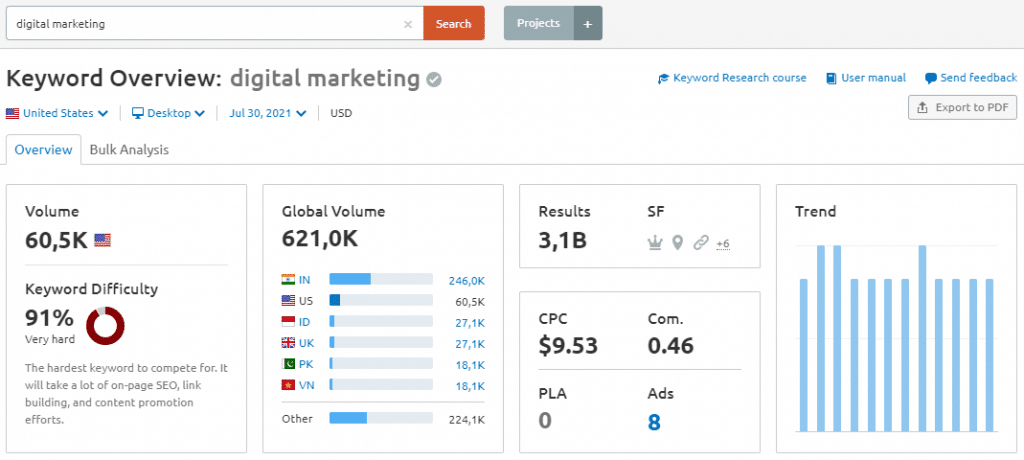
There’s a reason why SEMRush is considered one of the definitive SEO tools in digital marketing.
Not only is their platform incredibly robust, but it offers tons of features to help webmasters understand where and how their pages are ranking.
Specifically, their SEMRush Sensor works to look at all of your pages and keywords to determine areas where you might see volatility.
After running your website through the program, you should be able to determine if there’s a potential for a penalty and where you’ll want to make a fix.
Again, they’re one of the best SEO tools on the market.
The penalty checker is really just a bonus, so it is at least worth checking out their whole suite of services to see other changes you should make with your keyword strategy and overall content marketing plan.
2. Panguin
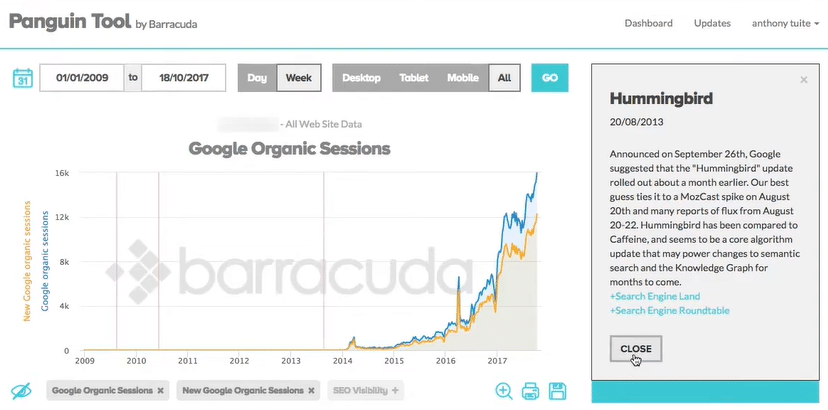
If you’re looking for the simplest and most direct way to check Google penalties, then you’ll want to take a look at the Panguin tool.
This program is designed solely for this one purpose, which means you won’t get distracted by other elements or data.
The tool works seamlessly with your existing Google Analytics account to overlay your organic traffic over the last two years and combines it with time frames when there was an algorithm change.
If you notice a significant dip in an area that does not correlate with a major upgrade, there’s a good chance this was due to a manual penalty.
One of the reasons why so many SEO managers love this penalty tool is that it is super simple, but that’s also the downside.
The dips aren’t always totally an indicator of a penalty issue, such as with seasonal content that might see a decline during off months.
However, it is a great option if you’re looking for a basic view of where your website stands.
3. Mozcast
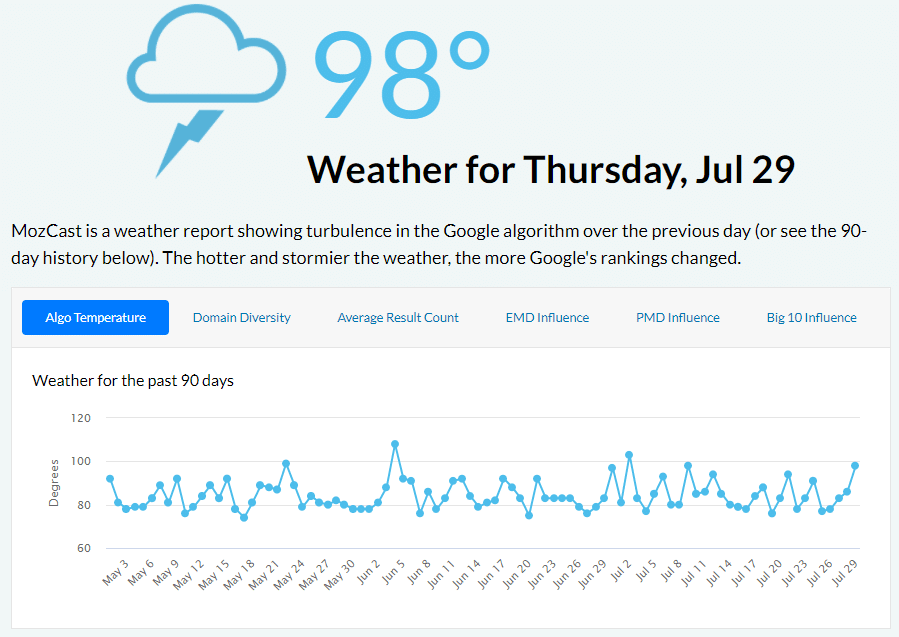
The folks at Moz are widely known for being a little witty and making algorithm changes a little more exciting.
When it comes to their Mozcast page, the theme is a take on the traditional weather forecast you might see on your local news.
The tool doesn’t show if you’ve been penalized, but it can help you spot unconfirmed changes in the Google algorithm.
A day with 98-degree weather on MozCast, for example, could indicate exactly that.
So, if you noticed a sudden drop in your traffic and there’s a really nice and pleasant weather on MozCast, maybe it’s a Google penalty.
4. Rank Ranger
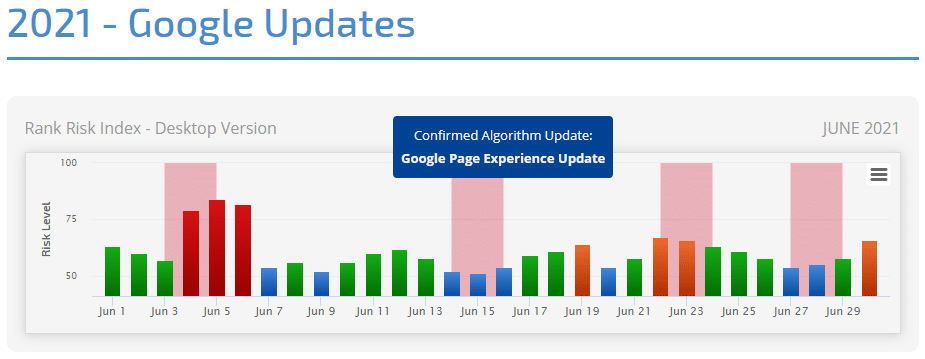
For those who get overwhelmed by too much analytics information, finding a tool like Rank Ranger is a good idea.
This super simple platform makes it easy to see if you’re at risk for problems, either due to algorithm changes or penalties.
The color-coded system goes from blue to red, offering a clear indicator as to whether you’re in the clear or if you should be worried.
The only problem? It doesn’t actually differentiate outright whether it is a specific issue with your website.
In that aspect, you’ll again have to check the climate of what’s going on in SEO to see if you need to make significant changes to your page.
The good news? You’ll only have to start worrying if you see a red day, as that would be the only time there was a risk of your site having a traffic issue.
The tool is also free, which makes it a good first step if you’re just trying to figure out why your traffic suddenly dipped and do not yet need any more in-depth information.
5. Google Search Console

Of course, you have to look to the source to really see if there’s a problem with your website and you’re under an official Google penalty.
This is where you’ll be notified if you’ve received a manual penalty and can take steps to request that one be removed after you’ve made changes.
In fact, this is usually one of the first places you should check if you notice there’s a significant drop in traffic on Google Analytics.
Search Console also offers links to a pretty in-depth number of best practice resources, making it a good place to look for ways to fix the problem if you are issued a penalty.
6. AccuRanker Grump

For a fun take on dealing with Google penalties, there’s AccuRanker Grump.
This whimsical little cartoon tiger is designed to help webmasters see a wide range of views on the overall climate of Google on a daily basis.
The grumpier the tiger, the bigger the fluctuation in rankings.
While this tool isn’t specific to one website, it does look at thousands of randomized keywords on a daily basis to see how well the top hundred results are faring.
Bigger fluctuations mean more volatility, which makes this dear kitty cat want to roar.
Translation? Don’t mess with a grumpy tiger. If you’re experiencing a traffic dip on a day when he’s unhappy, then it likely is Google as a whole.
If he’s happy? Well, time to take that personally and start looking for a possible penalty somewhere on your website.
7. FE International
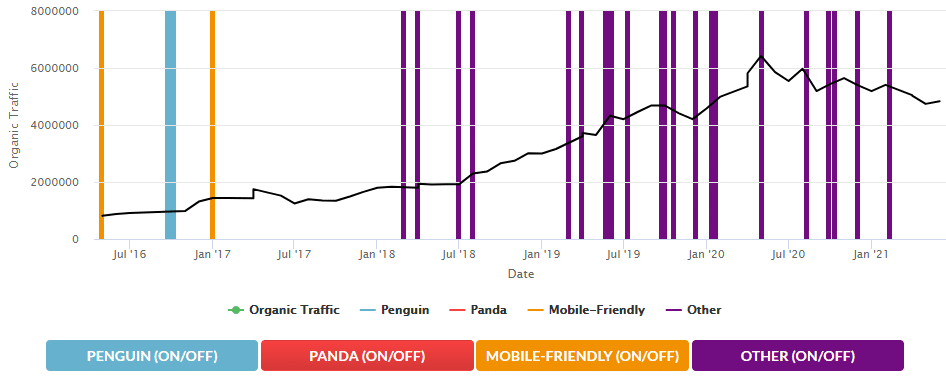
When it comes to website analytics, FE International knows its stuff.
As one of the bigger website sales and brokerage firms globally, they often look at long-term traffic as an indicator of the overall value of a website that’s going up for sale.
That said, it only makes sense that they would come up with a free tool to help website owners determine why they’re seeing specific traffic drops.
Much like a few of the other options on this list, there’s no need to log in or sign up to see data.
All you have to do is input your website address and you’ll see a chart with historical traffic data.
From there, you can compare specific increases and drops in traffic with colored Google algorithm changes.
But the part that makes this tool so unique is that you have the option to export the data for review later.
In short, this makes it easier to identify an issue and then bring it to the attention of your marketing team later on.
8. Fruition
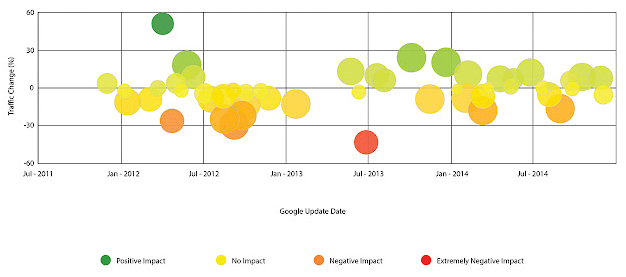
Finally, there’s Fruition’s Google Penalty Checker Tool.
Considered a freemium option, the program uses specific proprietary algorithms to look at a website’s past traffic data and determine whether there has been a true manual Google penalty or not.
Users of this program have reported back with mixed results, so remember that your mileage might vary.
However, it can really be a good indicator of an issue if you’ve used some of the free options on this list and still don’t have a clear picture as to whether there’s actually a problem.
What Can I Do If I Have Been Penalized?
Let’s say for a minute that you’ve used some or many of the eight tools we’ve included in this list and have determined that there is a penalty on your website.
What’s the next step to getting it fixed?
Step one: Determine where the issue is at
Usually, Google Search Console will give you an indicator of what you’re being penalized over, but this isn’t always the case.
Sometimes their reasoning is a little murky at best.
In that case, you might have to review a list of the most common infractions and decide areas where changes need to be made.
Step two: Make all appropriate changes
In most cases, you might only have to make a couple of quick changes to your website to alleviate the issue.
However, if you’re regularly engaging in activities that might be on the fringe of acceptable by Google, go ahead and fix as much as you possibly can.
After all, you don’t want them flagging you for something else when they do a future review, which could seriously jeopardize your traffic for even longer than just the initial penalty.
Step three: Request a reevaluation to remove the penalty
Using Google Search Console, request that you have the penalty removed.
Sadly, there is no exact time frame of how long this can take.
It actually depends on their backlog and whether there’s been a recent algorithm update.
Some webmasters report the issue resolving in a few days, while others have indicated it takes a few weeks.
Step four: Make sure you don’t repeat your mistakes
Once you’ve been cleared, it is important to take steps to ensure you don’t receive a penalty again in the future.
By always following Google’s best practices when it comes to your search engine optimization, you can prevent a detrimental drop in traffic from happening in the future.
Plus, you can even see a rise in traffic if you’re making all the right choices when it comes to how you optimize your page.
An extra win, right?
Wrap Up: Always Be Prepared With a Google Penalty Checker Tool
Experiencing a Google penalty can certainly be scary if you aren’t sure why you’re seeing such a dramatic drop in traffic.
The good news is that these eight Google Penalty Checker Tools are a good way to tell if there is an issue or if what you’re seeing is just a drop in web traffic due to an algorithm change.
And remember, none of these efforts will matter if you don’t have high-quality content. Google might not go as far as penalizing you, but you won’t rank well on the search engine results page (SERP) if your content isn’t considered relevant.
To assist you with that, we have WriterAccess. Our content creation platform can connect you with a vast community of skilled writers and creative professionals. I invite you to give it a try, completely free for 14 days!
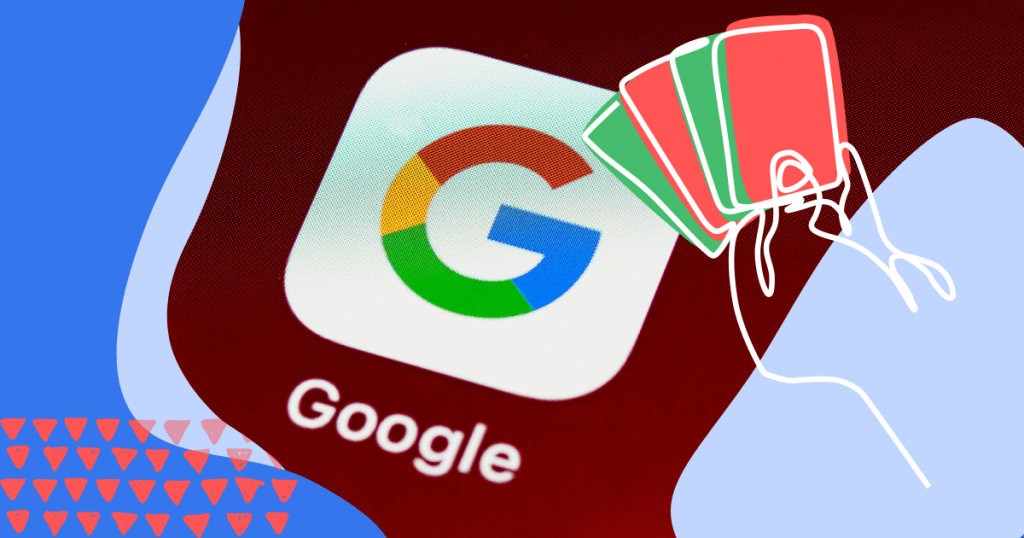

![[WA] Ultimate Content Marketing Kit](https://rockcontent.com/wp-content/uploads/2022/08/Content-Marketing-Kit-750x200px.jpg)


![[ROCK NA] [EBOOK SEO] Complete Guide](https://rockcontent.com/wp-content/uploads/2024/06/banner_Search-Engine-Optimization.png)





